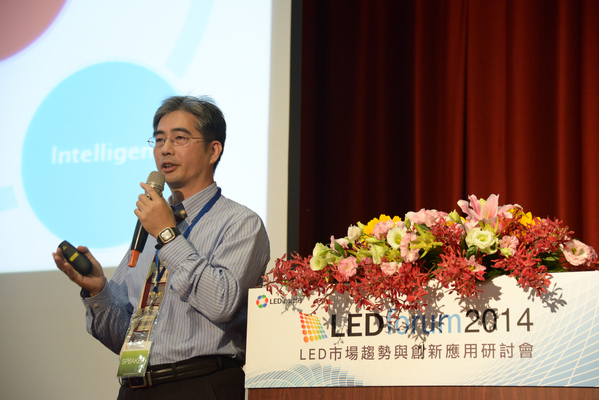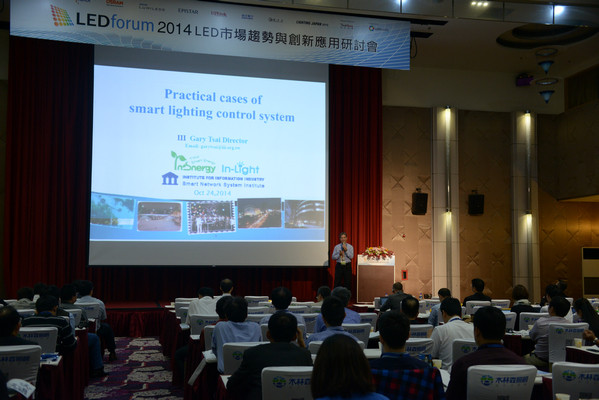Cost effective communication solutions are important for long range smart streetlight applications to make it acceptable to potential clients, said Gary Tsai, R&D Director, Institute for Information Industry (III) at LEDforum 2014 last Friday at Taipei, Taiwan.
According to the latest research from MarketsandMarkets, the market value of intelligent lighting will reach $ 6.75 billion in 2018. And the compound annual growth rate (CAGR) can be achieved to 36% from 2013 to 2018. “The smart lighting market is still much smaller than that of the previously mentioned LED market’s US $160 billion,” said Tsai. “Smart lighting is good for (manufacturers) product differentiation, and the resulting technology can be extended from downstream to upstream manufacturers.”
 |
|
Gary Tsai, R&D Director, Institute for Information Industry (III) delivers his presentation at LEDforum 2014. (LEDinside) |
So far most of the institute’s smart lighting products have been project based, but this makes it difficult to mass produce and export smart lighting products, said Tsai. “If all smart lighting products were project based, it will be difficult for smart lighting to become an industry because every project is a specialized system that cannot be exported,” remarked Tsai. Thus, the institute has been working on establishing a shared operation platform for smart lighting’s network, detection, analysis and application operations.
Smart lighting systems offer specific advantages in managing energy consumption, improve light quality, increase variety of lighting effects, and make maintenance easier by reporting faulty equipment. The system can also extend LED lifespan, and make the lighting more efficient.
Basically smart lighting constitutes of controllers, Internet networks, and data transfer. “The type of network smart lighting uses is very different from general PC or smartphones because it doesn’t require such a big network,” said Tsai. “This is why Zigbee and Power Line Communication (PLC) was developed.”
 |
|
Gary Tsai, R&D Director, Institute for Information Industry (III) photographed upclose during his presentation at LEDforum 2014. (LEDinside) |
Sensors in smart streetlights make it possible for the devices to relay information about broken lights, lighting quality, and reduce maintenance costs. “While smart streetlights can reduce maintenance costs, it also raises telecommunication costs,” said Tsai. “If every streetlight required 3G communication, it would bring a single lamp’s telecommunication costs to NT $700 (US $23) per month, which is not a very plausible solution.”
Zigbee and PLC communication protocols might be sufficient for solving indoor smart lighting applications, but not long distance communication issues found in smart streetlights. To solve this issue, the institute developed long distance WiFi, said Tsai. Instead of relying on public networks, such as 4G or LTE, the institute built a private network structure. WiFi and directional antennas was added to enable longer range transmissions.
The institute applied the WiFi smart lighting solution to a harbor project in Penghu Makong, Taiwan, which consists a network of 49 smart streetlights. Traditional smart lighting communication methods would require four mobile phone accounts to manage the complicated smart streetlight solution, which would scale up operating costs considerably, explained Tsai.
 |
|
Gary Tsai, R&D Director, Institute for Information Industry (III) speaks towards attendees at LEDinside. (LEDinside) |
One of Taiwan’s Industrial Park is currently using a smartlight system developed by the institute that integrates security cameras. The smart lighting system constitutes of 1,588 LED lights with six solar power equipment for 82 surveillance cameras. The system is capable of detecting whether weather conditions are affecting solar power equipment performance, and whether LED lights have broken down.
Technical difficulties still exist in developing smart streetlights, though. “It usually takes a pretty long period before the technology can reach the application stage,” said Tsai. Smart streetlight’s communication modules need to be compact enough to fit in the lighting product. Moreover, the communication components used in the smart streetlight has to be robust enough to endure very hot or humid weather conditions. “Currently, most streetlights near mountain regions use smart streetlights with dimmable capabilities,” explained Tsai.














